Dell XPS 15z: Sincerely Flattering
by Jarred Walton on September 2, 2011 1:30 AM ESTDell XPS 15z General Performance
Given the components, there aren’t many surprises in the performance metrics. The combination of i7-2620M CPU and GT 525M GPU delivers a solid showing. Here’s how things break down, for those that like charts. We’ve highlighted the 15z in bright green, the XPS 15 in black, an AMD A8-3500M in red, and the Toshiba L775D A6-3400M in orange. We’ve also included some results with the XPS 15z running alternate modes in dark green (e.g. using the IGP for PCMark 7 or testing at 1080p at medium details in the games).
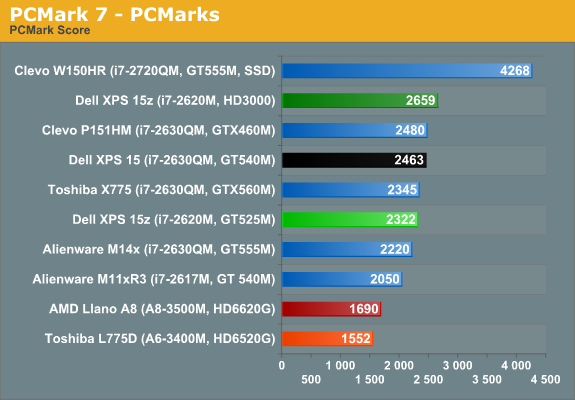
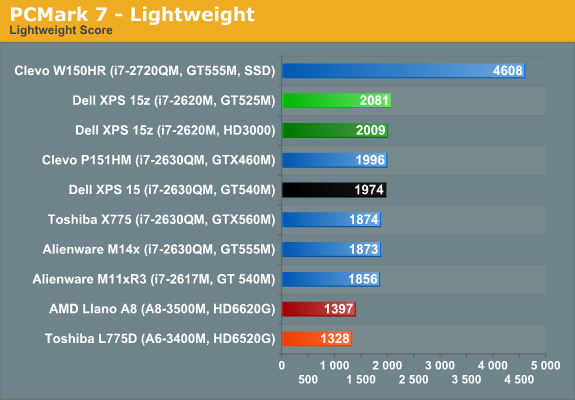

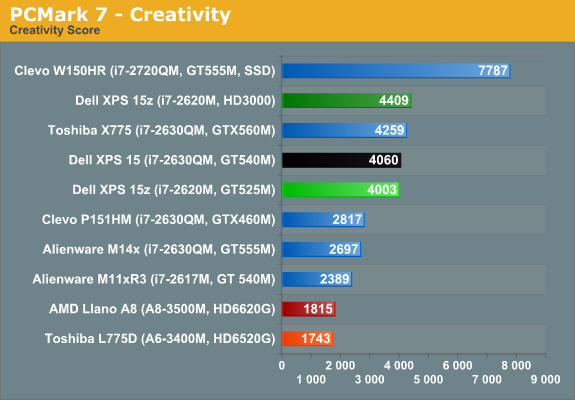
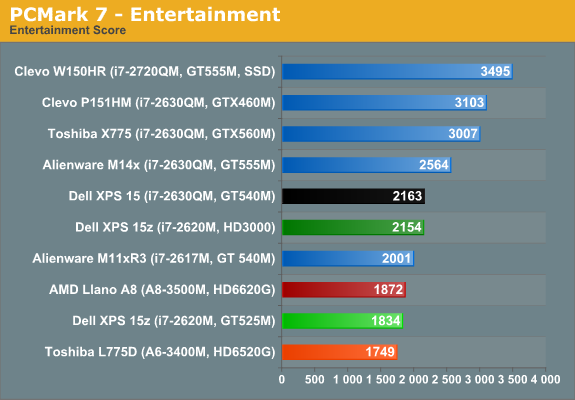
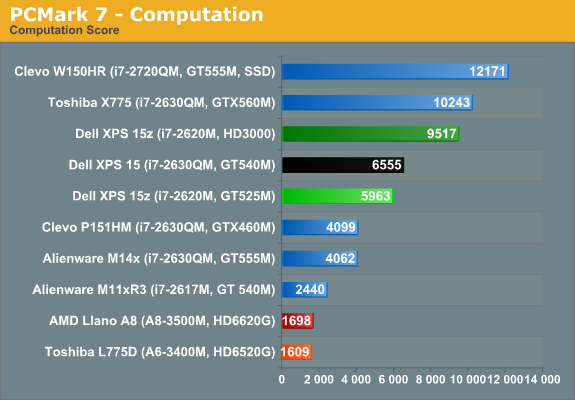
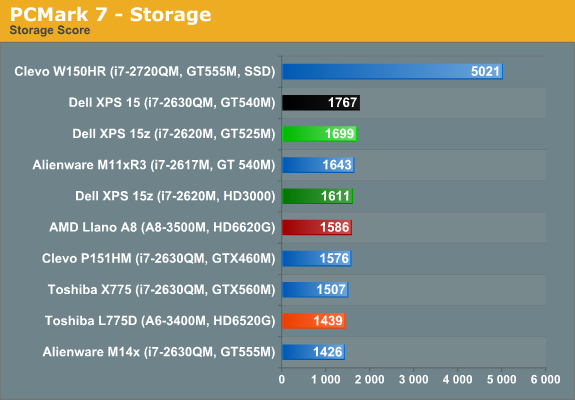
Starting with PCMark 7, the 15z places about where you’d expect, though it’s interesting to note once again how Intel’s HD 3000—and more importantly Quick Sync—boost performance in several areas to result in a 15% increase in overall performance. NVIDIA’s latest drivers appear to better recognize when to defer to the HD 3000, but we forced all of the tests to run on the GT 525M or the HD 3000 for the above results. As expected, the dual-core CPU generally finishes behind quad-core offerings, and anything with an SSD walks away with the performance crown. We’ll see the SSD factor once more in PCMark Vantage below, while the other benchmarks are CPU-centric.
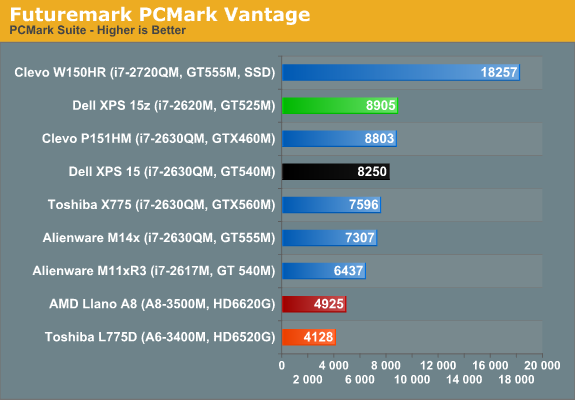
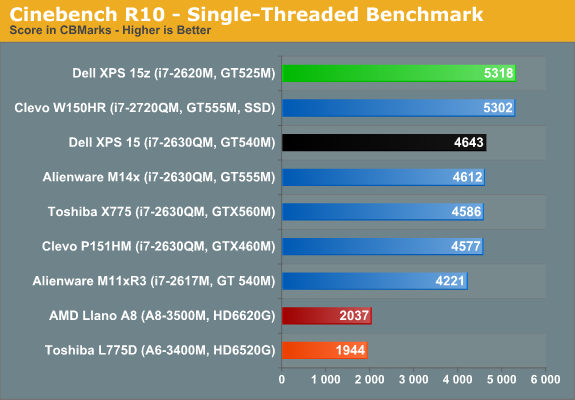
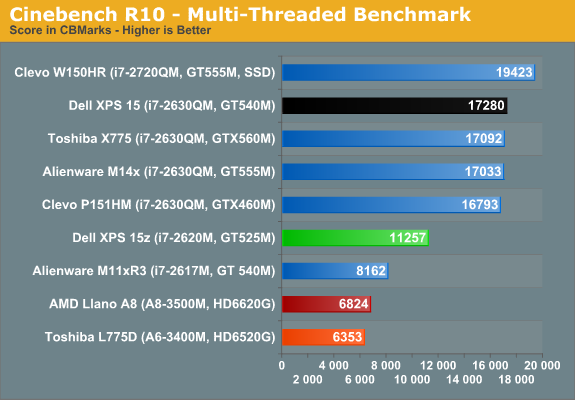
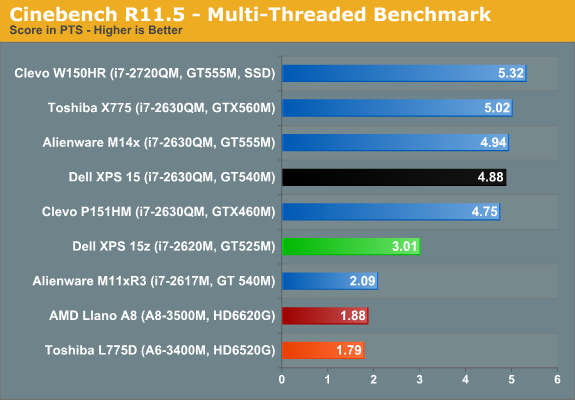
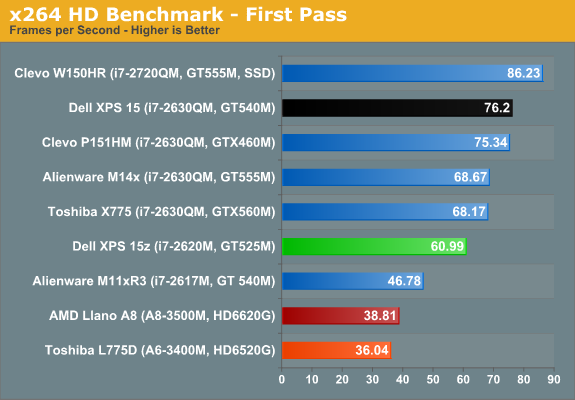
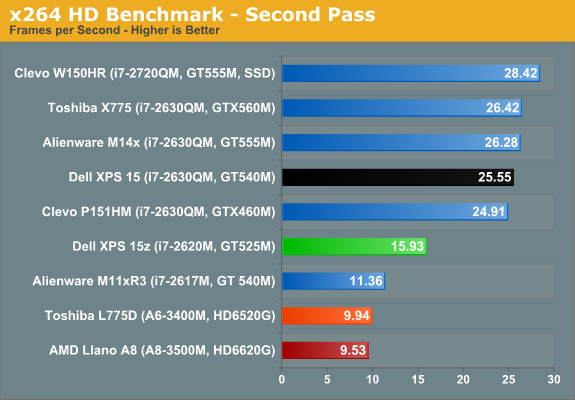
Interestingly enough, PCMark Vantage actually puts the 15z ahead of several other systems with quad-core CPUs. Either the test doesn’t scale with more threads as well as the latest iteration, or some driver updates are helping the 15z to surpass the competition—or perhaps a little of both. The single-threaded Cinebench result also confirms that the 2620M is a very fast CPU for lightly threaded workloads, while the remaining multi-threaded tests let the quad-core Sandy Bridge laptops spread their wings.
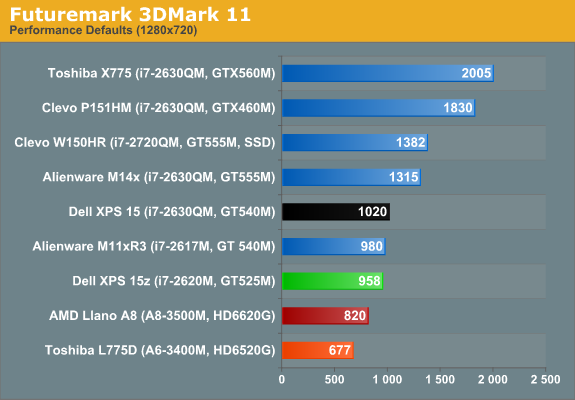
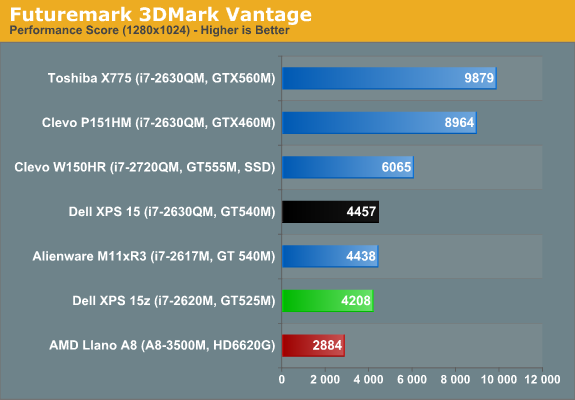
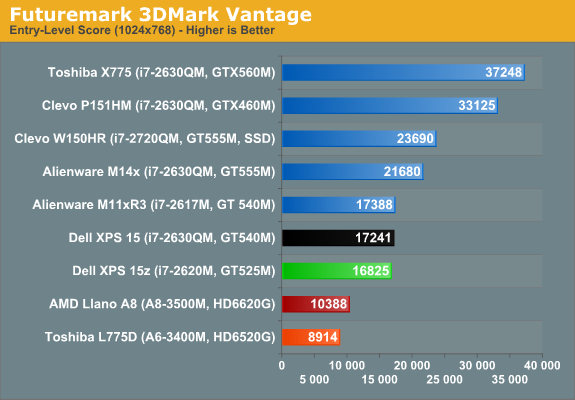
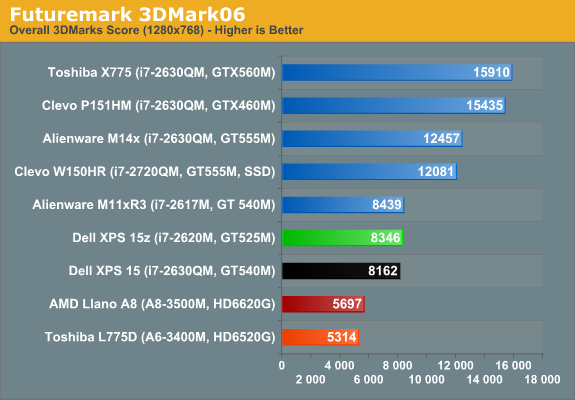
Wrapping up with some synthetic graphics tests, the GT 525M generally comes in just slightly behind the GT 540M but ahead of Llano’s HD 6620G and HD 6520G. AMD’s Radeon HD 6630M, incidentally, tends to offer slightly better performance than the GT 540M, at least when there’s enough CPU performance backing it. We’ll have a closer look at an Intel CPU with the HD 6630M in an upcoming review. So far, there aren’t any surprises—unless you consider the fact that the GT 540M is barely any faster than the GT 525M to be a revelation?










76 Comments
View All Comments
lukarak - Friday, September 2, 2011 - link
"In many ways the XPS 15z is a better laptop than the 15z,...." I might not be into Dell stuff, and there could be a Dell 15z as a separate model from XPS 15z, but i think you wanted to drop the Z the second time?Also, on topic, what's with the keyboard? If you copy the island design, don't mess with the shape of the keys, please.
JarredWalton - Friday, September 2, 2011 - link
Oops! Fixed, thanks. I actually call the MBP keyboard style "chiclet" and the Acer/Gateway stuff "floating island". Maybe others define "chiclet" differently? Anyway, typing on the 15z is actually quite nice, but like I mention I still prefer the XPS 15 keyboard layout.tbutler - Friday, September 2, 2011 - link
For those of us who remember the original 'chiclet' keyboards - the original PCjr, the TRS-80 CoCo, ZX Spectrum, etc. - the current keyboards aren't even CLOSE. :)The origin of 'chiclet' as a keyboard description was a derogatory term for those early keyboards - where the keys not only looked like chiclets, but were nearly impossible to touch-type on, because of both layout and the keyswitch design. Aside from the superficial look, the current keyboards have nothing in common; the layouts are 'normal', as are the keyswitches, and key travel is well within normal boundaries. Touch-typing is eminently possible, and in fact some of my favorite keyboards of the last couple of years have been in this style.
So yeah, I define 'chiclet' quite differently, and resist attempts to tar current keyboards with the same brush. :)
On another note: "The quality of the MBP15 display is better, but it’s hard to argue with a higher resolution and the 15z panel at least has a decent contrast ratio and brightness." On the contrary; I find it trivially easy to argue against a higher resolution. The 1440x900 MBP15 panel already causes me some eyestrain issues from the size of text and other interface elements, even at the admitted better display quality. The 1680x1050 panel was unlivable for extended use, and I can't even begin to describe the hurt a 15" 1080p display would cause me - especially if the overall display quality is lower.
iamezza - Friday, September 2, 2011 - link
this is what 'dpi' is forWindows 7 handles increasing the dpi very well, it can work with ALL programs. It can also be disabled on a per program basis if required.
Proph3T08 - Friday, September 2, 2011 - link
DPI is Dots per Inch usually when talking about monitors people use PPI (Pixels per Inch). A screen cannot change its PPI so anything Windows 7 would be doing would be software based to fake it.seapeople - Saturday, September 3, 2011 - link
You basically just agreed with him in a very strange way. DPI is how many pixels per inch the Windows interface renders certain UI elements such as window bars and text in. If you increase DPI, then Windows increases the resolution it uses to render text and other features, thereby making things bigger and easier to read without altering the actual pixel count being sent to your LCD screen, thereby preventing the blurriness you would otherwise get.neothe0ne - Friday, September 2, 2011 - link
"Dell gives you a GT 525M, which should be at least comparable to the HD 6750M in performance"I'm sorry but this can't possibly be true. The Radeon HD 5650M is a faster card than the GeForce GT 525M. How the hell could the GT 525M hope to compete with the 6750M?
Dustin Sklavos - Friday, September 2, 2011 - link
Agreed, the 6750M is more on par with the GT 540M if anything.Dustin Sklavos - Friday, September 2, 2011 - link
Actually, I'm incorrect. But either way, OP's point stands.I'm honestly really not impressed by the XPS 15z. 95C on the CPU cores is inexcusable, that keyboard sucks out loud, and the 1080p screen is among the worst we've tested in that class.
Also, anyone who deliberately spends up on the 2GB GT 525M upgrade deserves what they get. ;)
vol7ron - Friday, September 2, 2011 - link
I got my first Apple, which happened to be the 15" Macbook Pro. Worth the price? Not really. Apple OS freezes more than anything. It's only got a 2.0GHz QC, but I put a OWC SSD, 8GB of RAM, and upgraded to the anti-glare HD screen.So why do I like it? For the OS? no. For the keyboard? definitely no. For the trackpad gestures? kind of. For the quality screen? most definitely. The experience difference is in the screen alone. Viewing www.steampowered.com's opening page is an oddly different experience than viewing it on my desktop (better graphics card and more expensive monitors) and that's just for a static page. HD videos make it better too. I just wish it had better speakers - oh well.
XPS doesn't look bad, but the screen is where the user can really have that overwhelming sensation.